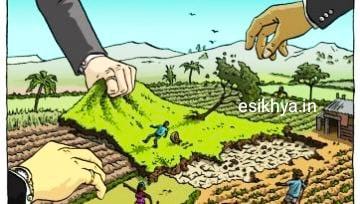Major Land Reforms in India
Land reforms in India have been a crucial aspect of the country’s socio-economic development. These reforms aimed to address issues related to land ownership, tenancy, and land distribution to promote equity and enhance agricultural productivity.
Major land reforms in India include :
1. Abolition of Zamindari System
- Objective: To eliminate the intermediaries (zamindars) who collected taxes from peasants and often exploited them.
- Implementation: The land was directly transferred to the tillers or cultivators, making them the landowners.
- Impact: Reduced exploitation, increased agricultural productivity, and betterment of the peasants’ economic conditions.
2. Tenancy Reforms
- Objective: To secure the rights of tenants and sharecroppers and ensure fair rent.
- Key Provisions:
- Security of tenure for tenants.
- Regulation of rent, usually capping it at one-third or one-fourth of the produce.
- Granting ownership rights to tenants in some cases.
- Impact: Improved the economic stability of tenants and encouraged investment in land improvements.
3. Ceiling on Land Holdings
- Objective: To reduce the concentration of land in the hands of a few and distribute it among the landless and small farmers.
- Key Provisions:
- Imposition of a ceiling on the amount of land an individual or family could own.
- Distribution of surplus land to the landless and marginalized sections of society.
- Impact: Facilitated equitable distribution of land, although implementation varied across states.
4. Bhoodan and Gramdan Movements
- Initiator: Vinoba Bhave.
- Objective: To voluntarily redistribute land among the landless through donations.
- Bhoodan: Landowners donated land to the movement, which was then distributed to the landless.
- Gramdan: Entire villages donated land, making the village a cooperative unit.
- Impact: Brought about some social change and awareness, though the scale of impact was limited.
5. Land Consolidation
- Objective: To consolidate fragmented and scattered landholdings to make agriculture more efficient.
- Implementation: Small and fragmented plots were consolidated into larger, more viable units.
- Impact: Increased agricultural productivity and better land management.
6. Protection of Tribal Land
- Objective: To safeguard the land rights of tribal communities and prevent alienation of their land.
- Key Provisions: Legal restrictions on the transfer of tribal land to non-tribals.
- Impact: Helped preserve tribal land and culture, though enforcement challenges remain.
7. Digital Land Records Modernization
- Objective: To modernize and digitalize land records to ensure transparency and reduce disputes.
- Implementation: Initiatives like the Digital India Land Records Modernization Programme (DILRMP).
- Impact: Improved access to land records, reduced corruption, and facilitated better land management.
Challenges and Criticisms

- Implementation Issues: Uneven implementation across states, bureaucratic hurdles, and lack of political will.
- Resistance: Resistance from powerful landowners and political influences.
- Legal and Social Challenges: Legal battles over land ownership, social conflicts, and issues with land acquisition.
Land reforms in India have had mixed success, significantly transforming rural landscapes in some areas while facing significant hurdles in others. They remain a critical part of India’s ongoing efforts to achieve social justice and agricultural development.
Share this content:


Leave a Reply